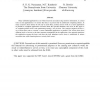316 search results - page 32 / 64 » Where do security policies come from |
STOC
2005
ACM
14 years 7 months ago
2005
ACM
In the setting of secure multiparty computation, a set of parties wish to to jointly compute some function of their input (i.e., they wish to securely carry out some distributed t...
DATE
2007
IEEE
14 years 1 months ago
2007
IEEE
Many embedded applications exist where decisions are made using sensitive information. A critical issue in such applications is to ensure that data is accessed only by authorized ...
CSREASAM
2008
13 years 9 months ago
2008
: Children's privacy has become critical with the increasing use of the Internet for commercial purposes and corresponding increase in requests for information. 65% of childre...
ICMI
2009
Springer
14 years 2 months ago
2009
Springer
Mobile medical sensors promise to provide an efficient, accurate, and economic way to monitor patients’ health outside the hospital. Patient authentication is a necessary secur...
CRYPTO
2011
Springer
12 years 7 months ago
2011
Springer
Deterministic public-key encryption, introduced by Bellare, Boldyreva, and O’Neill (CRYPTO ’07), provides an alternative to randomized public-key encryption in various scenari...

